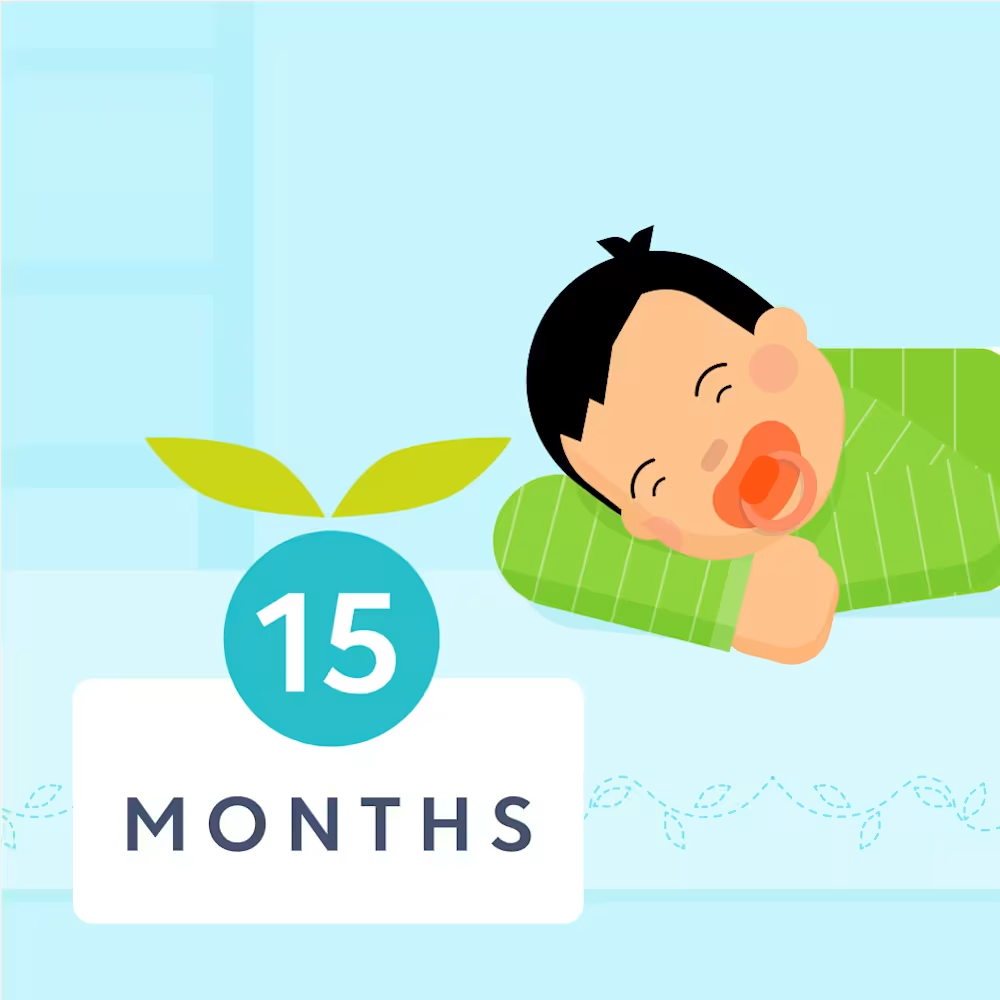15 month sleep regression: Myth or real?
Updated Nov 25, 2025

Once your child turns 1, you may think (or at least hope!) that you’ve made past the worst of the sleep regressions. Unfortunately, toddler sleep patterns tend to ebb and flow too and it’s not uncommon for more sleep bumps to pop up. The bright side? Not every 15 month old is destined for rocky sleep and we can help when challenges arise.
In this article, we’ll guide you through how to help you understand potential sleep struggles at 15 months, share tips on how to get your toddler’s sleep back on track, and answer frequently asked questions about sleep at this age.
Table of Contents
Is there a 15 month old sleep regression?
Although there isn’t a predetermined 15 month sleep regression, it’s not uncommon for children to experience sleep challenges around this age. If your little one has been sleeping well then goes through a period of bumpy sleep (calling out overnight, resisting or skipping naps, etc.), we’d consider this a sleep regression. However, every toddler is different and not all children will sleep poorly at this age.
Why do 15 month old toddlers have sleep issues?
Reason #1: They rely on parental help to fall asleep
Toddlers often have sleep challenges around this age due to parent-led sleep onset associations. This is when they get used to an adult helping them fall asleep and then depend on it. Commons include being fed, rocked, swayed, held, or patted to sleep. Children who rely on help to fall asleep are more likely to call out for an adult when they wake at night. Instead of going back to sleep independently, they seek parental help to recreate the same circumstance from the beginning of the night (or nap) to fall back to sleep (e.g. being held or rocked).
Reason #2: They’re ready to drop a nap
By 15 months, many toddlers are ready to drop a nap and move from nap per day. If your little one has outgrown their 2-nap schedule, they may resist naps (especially the second one), skip naps entirely, take shorter-than-usual naps, or suddenly start waking early. It may also be time to consider dropping a nap if your toddler has split nights (when they can’t sleep for long periods during the middle of the night) or is regularly getting less than 10 hours of sleep per night while on a 2-nap schedule.
Reason #2: They’re adjusting to schedule changes
Even if your little one is ready to drop a nap (or has already started to), the transition likely won’t happen overnight. Many toddlers switch between 2-nap and 1-nap days for a few weeks while they adjust to staying up for. It’s not uncommon for 15 months olds to become overtired when they drop to one mid-day nap, especially if it’s short. (It’s normal for the nap to be short at first and then lengthen to 2 - 3 hours eventually.)
As toddlers adjust to longer wake windows, they’re often overtired by bedtime. This can make it harder for them to fall asleep and stay asleep.
Reason #3: Separation anxiety
It’s common for toddlers to show new or increased signs of around 15 - 18 months []. These periods of clinginess or distress when separating from a caregiver are a healthy part of child development but may contribute to sleep challenges, especially when it’s time to lie down and sleep [].
Reason #4: Teething
Toddlers this age may also be dealing with teething pain as their first molars break through. As little ones cope with throbbing gums, they often seek more comfort — particularly at bedtime [].
Reason #5: Exploring boundaries
At 15 months, your little one is a bonafide toddler, which may mean they’re starting to act like one (and testing all the boundaries!). Between, we typically see little ones exploring their independence and pushing parental limits more. This may mean deciding they’d rather play instead of starting their sleep routine or trying to to snatch a book instead of settling down for a snooze.
How long does a 15 month sleep regression last?
Unfortunately there’s no concrete start and stop date for sleep regressions. The start, duration, and intensity of sleep challenges vary by child. Toddlers between 14 - 18 months commonly experience periods of rocky sleep (often referred to as the “”), but certainly not all. And how long poor sleep lasts depends on the root cause, as well as the steps taken to improve sleep. For example, if your little one has a sudden increase in night wakings because of teething pain, they may start sleeping better again faster than a child who’s resisting sleep due to ongoing separation anxiety.
My 15 month old won’t nap. Does 15 month regression affect naps?
Sleep regressions don’t just impact nighttime sleep. Along with night wakings and battling bedtime, toddlers in the throes of a sleep regression may also start fighting naps or taking much shorter ones.
If your 15 month old is suddenly struggling with daytime sleep and is resisting naps or skipping them altogether, they may be ready for longer awake periods or a nap transition. A schedule adjustment may help get daytime sleep back on track. If your toddler is still taking two naps, consider first lengthening awake periods to between 3.5 and 4 hours before their first nap (so they’re tired but not too tired). While lengthened wake windows may alleviate nap struggles for some children, others may be ready to drop their afternoon nap at this age and follow a 1-nap schedule.
However, not every child who’s struggling with naps at 15 months is necessarily ready for longer wake windows or dropping that second nap just yet. Naptime routines or other factors (like separation anxiety) may also impact daytime sleep at this age too.
If you’re feeling stuck and want more help with your toddler’s sleep, we can help! With, you can submit for a personalized, step-by-step Sleep Plan for your child.
6 tips to handle 15 month old sleep issues or regressions
Tip | Why it helps | What to try |
|---|---|---|
Encourage independent sleep skills | Toddlers who can fall asleep on their own tend to sleep longer and wake less overnight. | If you’ve been helping your child sleep, gradually reduce support so they can learn to fall asleep independently. |
Be flexible with bedtime | Transitioning from two naps to one can temporarily shift bedtime earlier or later. | On one-nap days, bedtime may need to be moved up to 6 PM. Offer earlier nights when total daytime sleep is under two hours. |
Keep an eye on nap times and lengths | Long or late naps can push bedtime later and lead to overtiredness. | If your toddler still takes two naps, limit the first nap to 90 minutes to keep the day balanced. |
Watch for signs your child is ready to drop a nap | Recognizing readiness helps prevent bedtime battles and nighttime disruptions. | Look for cues like shorter naps, skipped naps, or split nights — all signs your toddler may be ready for one nap. |
Factor in wind-down time | Calm transitions help toddlers shift from play to sleep mode. | Create a relaxing hour before bed with dim lights, bath, books, and cuddles. |
Be intentional about light exposure | Morning and evening light cues help regulate your toddler’s body clock. | Keep the room dark until wake time and avoid blue light and screens for an hour before bed to support healthy sleep rhythms. |
Find more details below:
Tip #1: Encourage independent sleep skills
If you’ve been helping your toddler fall asleep and they’ve come to rely on this support, consider teaching them independent sleep skills. Little ones who learn how to fall asleep with, and eventually, completely on their own, have fewer night wakings and longer stretches of sleep.
Tip #2: Be flexible with bedtime
When toddlers are on a 2-nap schedule, bedtimes often creep a bit later to allow more time for dinner and play before bedtime. But when your toddler drops to one nap, bedtime will likely move much earlier again (at least in the beginning). Many toddlers this age can only comfortably stay awake for about 5 hours at a time, which may mean suddenly shifting bedtime even as early as 6:00 PM, at first, depending on what time their one nap ends.
During this period of transition, it’s normal for naps to fluctuate between 1 and 2 naps. At this age, set bedtimes help align the circadian rhythm and sleep pressure, which can improve sleep overall. However, as they adjust to their new nap schedule, consider temporarily offering an early bedtime on days when total daytime sleep is less than ideal (under 2) — but no earlier than 6:00 PM or ~12 hours before your desired morning wake-up time. It may be a balancing act for a few weeks, but they’ll get there!
Tip #3: Keep an eye on nap times and lengths
At 15 months, some children are still following a 2-nap schedule. If this is the case, it can be helpful to to 90 minutes to avoid a very late afternoon nap and bedtime, which can result in more sleep challenges.
Tip #4: Watch for signs your child is ready to drop a nap
If your toddler is taking 2 naps and and naps are regularly challenging, these are good indicators that your little one is ready to move to a 1-nap schedule. Other common signs that your toddler may be ready to drop their afternoon nap include:
Resisting naps, especially the second one
Skipping naps entirely
Taking shorter-than-usual naps (often one sleep cycle)
Suddenly waking early and/or split nights (where a child can’t sleep for long periods during the middle of the night)
Tip #5: Factor in wind-down time
As kiddos get older, they need more space and time in their to transition from playtime to sleep time. Try to make the hour before bedtime a calm and relaxing one with simple bedtime rituals. This may look like a bath, brushing teeth, reading, and cuddles. Keeping the lights dim during this time supports melatonin production, the hormone that helps their body get sleepy. This extra wind-down time helps them understand and prepare for sleep to come next.
Tip #6: Be intentional about light exposure
Ill-timed exposure to light can also contribute to nighttime sleep struggles or early wakings. When light enters your toddler’s eyes [], it sets their circadian rhythm (or body clock for waking up and falling asleep). Being intentional about light exposure in the mornings and before bed can help improve sleep. Keep the bedroom dark until your desired wake time, especially if your little one wakes early. In the evenings, avoid screen time [] or electronics with blue light [] in the hour before bed.
How much sleep does a 15 month old need?
, most toddlers need about 13 hours of total sleep across a 24-hour period. This often breaks down into 11 - 12 hours overnight, plus around 2 - 3 hours during the day over 1 - 2 naps. Some children may have moved to a one-nap schedule at this age — most make the between 14 - 18 months.
If your toddler is sleeping a bit more or less than the typical range but wakes up happy and handles their day well, that works too! These are general guidelines, not hard rules. Paying attention to your child’s mood and energy levels are good indicators that they’re getting enough rest.
How can I tell if it's separation anxiety or 15 month sleep problems?
Separation anxiety can still appear around 15 months, though many toddlers are getting better at tolerating brief separations from caregivers. Your child is capable of understanding that when you leave, you will come back — even if they still become upset at times.
Separation at bedtime may be particularly tricky and contribute to sleep challenges, like having trouble falling asleep or more frequent overnight wakes. Offer reassurance, maintain predictable routines, and remember this phase is a normal part of emotional development.
How can I tell if it's teething or 15 month sleep problems?
At 15 months, toddlers may be cutting teeth, possibly painful first molars. Teething at this stage can lead to soreness, fussiness, and extra nighttime wake ups — so it's not so much teething or sleep problems. Offering extra comfort before sleep and maintaining consistent bedtime routines can help your toddler get the rest they need during this phase.
Can you sleep train during a sleep regression?
is an option when your child is 15 months, whether or not they’re experiencing a sleep regression. There are many methods to choose from — the “best” one suits your child’s temperament and your parenting preferences. Some approaches are gentler and take more time, while others can produce faster results and may include more tears in the short term.
Can I let my 15 month old cry it out during a sleep regression?
Most toddlers are developmentally ready for sleep training at 15 months, even when experiencing sleep challenges. There are various approaches to teaching your child to sleep independently. There are more structured methods like check and console (e.g. the ) that work well for many families. If you’re considering a “” (CIO) or extinction method, this may be more effective if check-ins tend to upset your child. Before going with this approach, ensure they’re fed, dry, and safe before putting them down. We also suggest keeping tabs with a video baby monitor. There are also approaches like Fading that can teach self-soothing skills while offering more support along the way. These methods typically take longer (a couple of weeks or more) to produce results. Whatever method you go with, trust your instincts and adjust as needed. We also recommend checking in with your kiddo’s pediatrician before getting started.
What are self-care tips for tired parents?
Fuel up: Let’s face it, feeding a toddler can feel like a full-time job in and of itself. In the chaos of fetching snacks, it’s easy to deprioritize your own eating habits. Instead, try keeping healthy snacks on hand, make sure you’re hydrated, and try not to skip meals. Your blood sugar and overall mood will thank you!
Plan something to look forward to: Have you ever noticed that everything feels easier when you have your eye on a prize? Whether it’s a trip to your favorite bakery or a walk with a friend, give yourself something small (or big!) to look forward to. Even the hard days may feel a little more tolerable when you’re inching toward a special moment.
Create your own calm before bed: Chances are your toddler has a step-by-step bedtime routine to guide them toward slumber — how about you? Calming bedtime routines can be great for grown-ups too! Try including steps like dimming the lights, reading a few pages of a book, or listening to calming music. Ending the day on a happy, peaceful note can help you drift off to sleep and reset.
Should I let my baby sleep in my bed during a regression?
To reduce the risk of SIDS, the American Academy of Pediatrics (AAP) advises against bedsharing during a baby’s first year []. After 12 months, that guidance becomes less specific, though they still don’t formally endorse bedsharing. However, the risk of SIDS drops by this age. That said, it’s still important to be mindful of other safety concerns like falls, suffocation, and entrapment.
Many families choose to bedshare at this age, especially during periods of rocky sleep. If you bring your child into bed, aim to keep things as safe as possible. Some safety practices include:
Keep pillows and heavy blankets away from your child
Use a firm mattress
Avoid sharing the bed with anyone under the influence of substances that affect alertness
When to talk to a doctor
Sleep can be bumpy in the toddler years too and oftentimes this is perfectly normal. However, there are times when you may be concerned about how (or how much) your child is sleeping. Here are some signs to watch for that may indicate it’s best to check in with their healthcare provider:
Feeding or weight gain concerns: If your little one is consistently skipping meals or not gaining weight as expected (though growth slows down in your baby’s second year), reach out to their doctor.
Unusual symptoms: Vomiting, a lingering cough, fever, rash etc.
Persistent fussiness: When children show signs of pain or seem extra hard to soothe, consider seeking medical advice to rule out other possible causes.
Sleeping much more than usual or hard to wake: Check in with their healthcare provider if your toddler is sleeping significantly more than usual, seems overly drowsy, or is hard to wake.
Other red flags: Always trust your instincts! You know your child best — reach out to their healthcare provider if something feels off. It’s often better to err on the side of caution in these instances.
Takeaway
Sleep regressions are a normal part of development and can happen at any age.
Toddlers around 15 months may experience sleep issues due to various factors, including dropping a nap, adjusting to schedule changes, teething, separation anxiety, and exploring new boundaries.
The duration of sleep issues will depend on the cause and the steps taken to alleviate them.
To help get sleep back on track, keep an eye on nap lengths, consider adjusting bedtime and/or their nap schedule, factor in more wind-down time before bed, consider whether they are falling asleep independently, and be mindful of light exposure.
15 month sleep regression FAQ
Share article:
Note: The content on this site is for informational purposes only and should not replace medical advice from your doctor, pediatrician, or medical professional. If you have questions or concerns, you should contact a medical professional.
7 Sources
Table of Contents
Share article:





